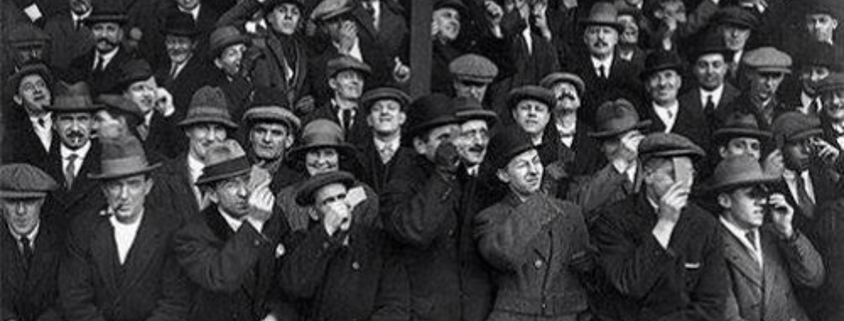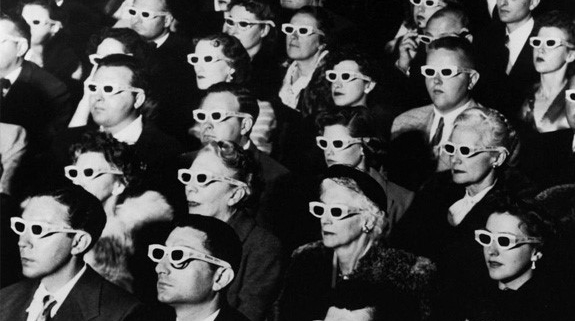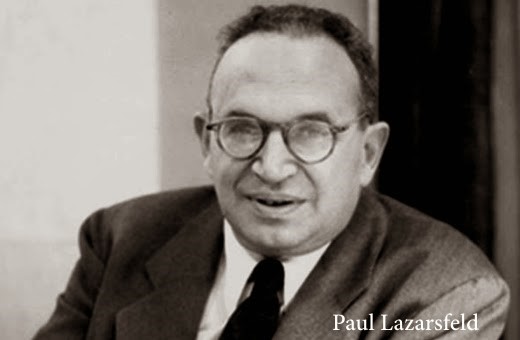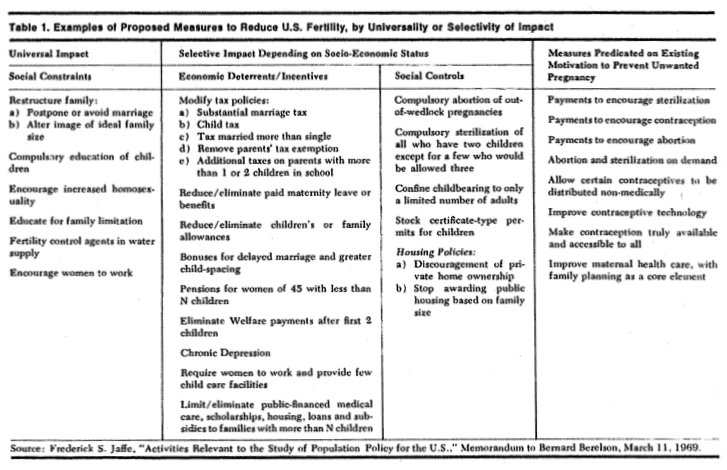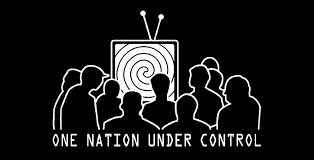Ways of Seeing: Who Determines Your Reality?
“What has happened since World War II is that the American sensibility has become part Jewish, perhaps as much Jewish as it is anything else…The literate American mind has come in some measure to think Jewishly. It has been taught to, and it was ready to. After the entertainers and novelists came the Jewish critics, politicians, theologians. Critics and politicians and theologians are by profession molders; they form ways of seeing.”—New York Times Theater Critic Walter Kerr, writing in 1968
In a media-saturated society, with said media almost completely under Jewish control, the Jewish “way of seeing” retains not just its primacy but its virtual monopoly. In such an environment, what you see will be determined for you, and as one who is to be molded, the aim is for your very will to no longer be your own.
The music industry is, as with all forms of media, dominated by Jews, and its control has become increasingly centralized, another trend we’ve seen irrespective of the industry in question. In December 1998, with the PolyGram-Universal merger, the music industry’s Big Six became its Big Five, in control of 77.4% of a market estimated to be between $30 and $40 billion; 2004 saw another merger, this time of Sony and BMG (Sony would later buy out BMG), to create a Big Four. Coupled with the shrinking of independent labels, the Big Four were in control of a whopping 88% of the market by 2011. In December 2011, EMI was absorbed by the Universal Music Group and Sony Music Entertainment, though in Europe regulators forced Universal Music to sell off its EMI assets which became the Parlophone Label Group, and was then promptly acquired by the third member of the Big Three, Warner Music Group. In 2012, the Big Three represented 88.6% of the market. Sony Entertainment, the sixth-largest entertainment company in the world, owns Sony Music Entertainment, and Vivendi, number seven, owns Universal Music Group.
A snapshot of the leadership of the Big Three proves illustrative; this overview from December 2019 reveals an obscene overrepresentation of Jews including Michael Lynton, Chairman of the Board for the Warner Music Group and its Vice Chairman, Len Blavatnik; of the nine other members of the Board, Noreena Hertz, Ynon Kreiz, Thomas H. Lee, and Alex Blavatnik (Len’s brother) are Jewish. Mathias Dopfner is a Gentile, but is also a self-described “non-Jewish Zionist.” The rest, such as Stephen F. Cooper—also the CEO, replacing the Jewish Edgar Bronfman, Jr.—are either contested or I could not definitively find out. Co-Chair and CEO of Warner Records, Aaron Bay-Schuck, has Jewish ancestry, and other prominent Jews in management include Eric Levin, Warner Music Group CFO and Executive Vice President, and Co-Chair and COO of subsidiary Atlantic Records Group Julie Greenwald and its Co-Chair and CEO Craig Kallman. Universal Music Group Chairman and CEO Lucian Grainge is Jewish, as are: Chairman and CEO of the Universal Music Publishing Group’s global publishing division, Jody Gerson; Chairman and CEO of Universal Music UK and Ireland, David Joseph; and Executive Vice President of Marketing Andrew Kronfeld. Sony Music CEO Rob Stringer is Jewish, as is its COO Kevin Kelleher, Executive Vice President and General Counsel Julie Swidler, and President of Global Digital Business and US Sales Dennis Kooker. In other words, all three major record labels are headed by Jews and their corporate governance is dominated by Jews as well. The rest, like RCA Records CEO Peter Edge, are “well-liked Gentiles.”
Just four conglomerates control 90% of the entire US television and films markets: Comcast (including NBCUniversal), Disney, ViacomCBS (controlled by National Amusements), and AT&T (including WarnerMedia). AT&T and Comcast are also two of the three largest telecommunications providers in the United States. These conglomerates are, in fact, almost entirely Jewish-controlled. Jews are overrepresented at places like CNN (a WarnerMedia subsidiary) by a factor of twenty-five and are over-represented among senior executive positions at the major television broadcast networks, cable networks, and movie production companies by a factor of 44.5! With positions current as of December 2019, we see that Bob Bakish, President and CEO of ViacomCBS, is Jewish as are:
- John T. Stankey, CEO of WarnerMedia and President and COO of AT&T
- Comcast Chairman and CEO Brian L. Roberts
- Jeff Zucker, Chairman of WarnerMedia and President of CNN Worldwide
- Bob Iger, Chairman and CEO of Disney
- Jeff Shell, Chairman of NBCUniversal Film and Entertainment
- Ron Meyer,Vice Chairman of NBCUniversal
- David L. Cohen, Senior Executive Vice President and Chief Diversity Officer of Comcast
- Kent Alterman, President of Comedy Central (under ViacomCBS), Paramount Network (also under ViacomCBS), and TV Land (under MTV Networks, a division of ViacomCBS, which also owns MTV, VH1, Nickelodeon and Nick Jr.)
- Shari Redstone, President of National Amusements and Chairwoman of the Board for ViacomCBS
- Sumner Redstone, majority owner and Chairman of the Board of National Amusements; through National Amusements, Redstone and his family are majority voting shareholders of ViacomCBS and its subsidiaries such as MTV Networks, Paramount Pictures, Comedy Central, and BET
Randall L. Stephenson, Chairman and CEO of AT&T and former National Chair of the Boy Scouts of America during its “inclusivity” demise (when girls were allowed to join the Boy Scouts) is not Jewish, but was awarded an “honorary yarmulke.”
Other recent principal figures include:
- Jeffrey Katzenberg, major Barack Obama donor and former Disney and Paramount executive, co-founder of DreamWorks Pictures and WndrCo, and founder of Quibi (which has been invested in by Disney, 21st Century Fox, NBCUniversal, Sony Pictures Entertainment, ViacomCBS, WarnerMedia, Lionsgate, MGM Studios, ITV, Entertainment One, Alibaba, Madrone Capital Partners, Goldman Sachs, JP Morgan Chase, and more)
- Michael Eisner, former Chairman and CEO of Disney
- Ralph J. Roberts, co-founder, former CEO, and Chairman Emeritus of the Board of Comcast
- Richard Plepler, member of the Council on Foreign Relations and former Chairman and CEO of HBO (now under WarnerMedia)
- Les Moonves, Chairman and CEO of CBS Corporation from 2003 until his resignation in September 2018 following numerous allegations of sexual harassment and abuse and current member of the Board of Directors at ZeniMax Media
- Former Paramount Chairman and CEO Brad Grey (Paramount is now a ViacomCBS subsidiary)
- Jordan Levin, member of The WB’s founding executive team and a former CEO; former Microsoft Xbox Entertainment Studios Executive Vice President-General Manager to Produce Original Programming; founder and former CEO of Generate, a production studio and talent management company; former Chief Content Officer at the NFL; former CEO of Awesomeness, an American media and entertainment company eventually purchased by Viacom; and current General Manager of Rooster Teeth, an entertainment company and subsidiary of Otter Media which is a subsidiary of WarnerMedia
- Former Warner Brothers (now under WarnerMedia) Chairman and CEO Barry Meyer, who was also on the Board of Directors for the San Francisco branch of the Federal Reserve
- Julian Brodsky, co-founder and former CFO and Vice Chairman of Comcast, as well as co-founder and former Chair of Comcast Interactive Capital, Comcast’s venture capital unit
A quick perusal of other major players in film and television, supporting and affiliated industries, print and online news media, and digital and social media not considered part of the “traditional” media market (though no less important to the media apparatus, and arguably more so) once again reveals a massive overrepresentation of Jews in ownership or otherwise prominent positions (current as of December 2019), including:
- Tom Rothman, Chairman of Sony Pictures Motion Picture Group
- Josh Greenstein, Co-President of Sony Pictures Motion Picture Group
- Former Vice President of US Business Development for Bertelsmann Media Suzanne Nossel
- Peter Chernin, former News Corp. Chairman and current Chairman and CEO of The Chernin Group (assets include Chernin Entertainment; a majority stake in CA Media, an Asia-based media investment company; and Pandora, Fullscreen, Tumblr, Barstool Sports, and Flipboard)
- Record company magnate and DreamWorks co-founder David Geffen
- Lionsgate CEO Jon Feltheimer
- Lionsgate Chairman Mark Rachesky
- Facebook founder Mark Zuckerberg
- Facebook COO and ADL-donor Sheryl Sandberg
- YouTube CEO Susan Wojcicki (her sister founded 23andMe)
- Former Co-Chair of Sony Pictures Entertainment and current head of Pascal Films (which produced the atrocity known as the Ghostbusters re-make) Amy Pascal
- Relativity Media CEO Ryan Kavanagh
- “Committed Zionist” Sam Zell, founder and chairman of Equity Group Investments and formerowner and CEO of the Tribune Company, which counted among its assets 23 televisions stations, a baseball team, and many major newspapers, including the Chicago Tribune and the Los Angeles Times
- “Super-agents” Scooter Braun and Ari Emanuel (Rahm Emanuel’s brother and inspiration for the character Ari Gold in HBO’s series Entourage)
- Joel Klein, former CEO of Amplify, Executive Vice President at News Corp., and former Chairman and CEO of Bertelsmann, Inc.
- Lloyd Braun, Chairman of the ABC Entertainment Group from 2002 to 2004, former head of Yahoo! Media Group, who partnered with Gail Berman to form the entertainment company BermanBraun, eventually becoming the sole owner and renaming the company Whalerock Industries
- Mort Zuckerman, owner of the US News & World Report, former owner of the New York Daily News, The Atlantic, and Fast Company, and former chair of the Conference of Presidents of Major Jewish American Organizations, one of the largest pro-Israel lobbying groups in America
- Haim Saban, founder of Saban Entertainment, the Saban Music Group, and Saban Capital Group, a stakeholder in Univision (Saban: “I’m a one-issue guy, and my issue is Israel.”)
- Mega-producer and member of the Board at ZeniMax Media Jerry Bruckheimer
- Harry Sloan, former Chairman and CEO of Metro-Goldwyn-Mayer and Board member at ZeniMax Media
- ZeniMax Chairman and CEO Robert Altman (ZeniMax’s legal counsel is none other than DLA Piper, which features prominently in The Way Life Should Be?)
- Fox Entertainment CEO Charlie Collier
- Michael Lynton, from earlier, also former CEO of Sony Corporation of America, now Chairman of Snap Inc. (Snapchat) and as mentioned Chairman of the Board of Warner Music Group (Lynton is also a member of the Council on Foreign Relations; his brother-in-law is “progressive” journalist and correspondent Jonathan Alter and his mother-in-law, Joanne Hammerman/Alter, was a “progressive” politician who worked closely with Bella Abzug, all Jewish)
- Nicole Seligman, former President of Sony Corporation of America and Sony Corporation general counsel and former representation of Oliver North during the Iran-Contra hearings and Bill Clinton during his impeachment trial (her husband Joel I. Klein was an official in the Clinton administration and is the former Chancellor of the New York City Department of Education, preceded by the Jewish Harold Levy and appointed by the Jewish Michael Bloomberg; in an illustrative example of Jewish nepotism, Wikipedia states that Klein, “never obtained the common formal credentials that one would have to take a leadership role in a public school system, and…had a short duration of teaching experience”; in 2005, Klein fired Rashid Khalidi from the teacher training program for his views on Israel)
- Leonard “Len” Blavatnik, from above, also owner of AI Films and founder and Chairman of Access Industries—Access Industries owns the Warner Music Group
- The New York Times Company is controlled by the Jewish Ochs-Sulzberger family through a special class of “super-voting” shares
- Donald Edward Newhouse, owner of Advance Publications whose properties include Condé Nast, dozens of newspapers across the US, cable company Bright House Networks, and a controlling stake in Discovery Inc.
- President and CEO of Discovery Inc. David Zaslav (Zaslav serves on the Boards of Sirius XM Radio, Inc., Lions Gate Entertainment, the National Cable & Telecommunications Association, The Cable Center, Center for Communication, Grupo Televisa, Partnership for New York City, and the USC Shoah Foundation, and is the Chair of the Auschwitz: The Past Is Present Committee)
- Google co-founder and Alphabet Inc. President Sergey Brin
- Google co-founder and Alphabet Inc. CEO Larry Page
- The Weinstein brothers Harvey and Bob of the now-defunct Weinstein Company movie studio
- Former Vice Chairman of Vivendi Universal and former Warner Music Group Chairman and CEO Edgar Bronfman, Jr.; and the list goes on. Bronfman:
Is the son of Edgar Miles Bronfman and the grandson of Samuel Bronfman, patriarch of one of the wealthiest and most influential Jewish families in Canada. The Bronfman family gained its fortunes through the Seagram Company, an alcohol distilling company. Edgar Jr. is the second of five children of Ann (Loeb) and Edgar Miles Bronfman. His mother was the daughter of John Langeloth Loeb Sr. (a Wall Street investment banker whose company was a predecessor of Shearson Lehman/American Express) and Frances Lehman (a scion of the Lehman Brothers banking firm)…Edgar M. Bronfman, Jr., is the son of Edgar Bronfman, Sr., the billionaire businessman and longtime president of the World Jewish Congress who died aged 84 in 2013. He is the half-brother of Clare Bronfman, who as a 39-year-old was charged in 2018 in a NXIVM sex-trafficking case…In 1979, Bronfman married his first wife, Sherry Brewer, an African-American actress, in New Orleans. Bronfman’s father did not approve of the marriage. ‘I very much wanted for him to end the relationship, because I told him, all marriages are difficult enough without the added stress of totally different backgrounds,’ Bronfman Sr. wrote in his memoirs. ‘Sherry offered to convert [to Judaism], which though well intentioned, was not the point.’…On January 21, 2011, Bronfman was found guilty in French court of insider trading [while with] Vivendi…and received a 15-month suspended sentence and a €5m fine.[1]
Vivendi acquired the Bronfman family’s Seagram Company in 2000.
This could all be sound and fury signifying nothing, however, as these people “just happen to be Jewish,” pace former Anti-Defamation League National Director Abe Foxman, and thus we shouldn’t make anything of the comments by Robbie Brenner, head of Mattel Films and President of The Firm’s film division—“Everyone had a similar kind of look, the know-your-tribe look—the Jews from New York”—or that in writing the screenplay for Crouching Tiger, Hidden Dragon, co-writer and former Focus Features CEO James Schamus said that, rather than try to create authentic Chinese characters, he tried to write them “to be as Jewish as possible.” We shouldn’t make anything of the fact that, as Mike Konrad writes:
The popular TV show Bridget Loves Bernie was canceled because some Jewish pressure groups were furious that American TV approved of Jewish-Christian intermarriage. Meredith Baxter said, “We had bomb threats on the show. Some guys from the Jewish Defense League came to my house to say they wanted to talk with me about changing the show.” Threatening phone calls made to the home of producer Ralph Riskin resulted in the arrest of Robert S. Manning, described as a member of the Jewish Defense League. Manning was later indicted on murder charges, and fought extradition to the U.S. from Israel, where he had moved. Needless to say, the quite popular show was canceled. Ironically, soon after that, the CBS network didn’t mind featuring an interracial couple on the The Jeffersons.[2]
Similarly coincidental and inconsequential, from “Jewish Media Power: Myth and Reality” by Elana Levine and Michael Z. Newman:
In a society in which Jewish identity exists in tension with gentile whiteness, Jewish power over media has been a source of as much anxiety as celebration…The new movie studios and networks were run largely by Jewish immigrant moguls or their offspring: the Warner brothers, Adolph Zukor (Paramount), David Sarnoff (RCA/ NBC), and William S. Paley (CBS), among others. Both news and entertainment remain fields hospitable to Jewish artists and businesspeople, from CEOs like Bob Iger (Disney) and producers and company presidents like Jeff Zucker (CNN, NBC) to writers and directors like Nora Ephron and Steven Spielberg. Jewish journalists have led the most influential news organizations in the United States, including the Times and Washington Post. Jews are heavily represented in creative and media workplaces and occupy many positions of prestige and authority.[3]
Even PBS, “the nation’s largest non-commercial media organization with nearly 350 member stations throughout the country,” is under Jewish management in the form of President and CEO Paula Kerger.
In the UK, the Rothschilds through EL Rothschild own a 21% stake in The Economist Group, the media group responsible for The Economist. Lady Lynn Forester de Rothschild sits on its Board (as well as that of Estee Lauder; she is the Chair of EL Rothschild investments—EL Rothschild is distinct from Bronfman EL Rothschild LP of yes those Bronfmans and yes those Rothschilds, which was recently acquired by NFP whose President and COO is Mike Goldman); Eric Schmidt, former CEO of Google, is a former Board member of The Economist Group. Former Chairman of Guardian Media Group (publisher of The Guardian) Paul Myners has ties to RIT Capital Partners PLC, formerly Chaired by Jacob Rothschild. It has a net value of approximately £3 billion, and Jacob Rothschild is today Honorary President with his family remaining the largest shareholders at around 21%. Jacob Rothschild’s eldest daughter, Hannah Mary Rothschild, has done a lot of work with the BBC and is also a Non-Executive Director of RIT Capital. “Feminist press” Virago published a biography she wrote about her great-aunt in 2012; Virago’s 1987 management buy-out of the press from CVBC, which included current Chair Lennie Goodings, was co-financed by Rothschild Ventures.
To disprove the falsehood that Jews exert inordinate control over the international media, Argentine model and TV presenter Ursula Vargues was fired from her job in 2017 for her “anti-Semitic tweets.” What did she say? That Jews control the media.
Wealth is also disproportionately concentrated in the hands of global Jewry. Depending on the year in question, the percentage of the Forbes 400 for the four hundred wealthiest Americans is usually around one-third or more despite comprising just 1.5% of the US’s population. In 1987, Nathaniel Weyl found 23% of American billionaires were Jewish, whereas for the last decade, the number has settled in at around a third. The Jewish Telegraphic Agency states that for 2009, at least 139 of the Forbes 400 were Jews, with 20 of the top 50 controlling $211.8 billion in personal wealth. Six of the top ten wealthiest Americans on the 2019 Forbes 400 list are Jewish, 18 of the top 40 are Jewish, and at least 33 of the top 100 are Jewish. 11.6% of the world’s billionaires are Jewish, despite Jews accounting for just 0.2% of the world’s population. Five of the top seven wealthiest Aussies are Jewish, despite accounting for less than 0.5% of the nation’s population. 20% of Britain’s “Super Rich” are Jewish—and most of them are immigrants. Jews are 25% of Canada’s billionaires (at roughly 1% of the population), 13% of Brazil’s (at 0.5% of the population), and 43% of the Ukraine’s (at roughly 1% of the population). Jews are 15-17 times more likely per capita to make the Forbes 400 than is the rest of the American population. A 2008 survey from the Jerusalem Post found that 46% of Jews earn at least $100,000 a year, compared to the 18% US average. IQ differential alone is not enough to explain this disparity; the overrepresentation is too dramatic.
Jews, by the way, are 26.4% of South Africa’s wealthiest individuals whilst representing an absurdly-small .09% of the population. They have profited enormously from the diamond trade. Things are clearly going well for the Jews in South Africa, but for whites it is a different story. Per Henk van de Graaf: “The farmers live in fear, because being a farmer in South Africa is the most dangerous occupation in the world. The average murder ratio per 100,000 for the population in the world is nine, I believe…But for the farming community it is 138, which is the highest for any occupation in the world.” I have seen lower murder rates for white farmers at 97 per 100,000, but that is still astronomical. In 2019, it was 36.4 per 100,000 people for all of South Africa, which is horrible but much rosier than the 67.9 per 100,000 people in 1995 per Bloomberg. According to the Institute for Security Studies, the murder rate in South Africa in 1994 was 66.9 murders per 100,000 people.
Whites are less than 9% of the South African population presently, but consider that in 2001, the police’s Crime Information Analysis Centre revealed that of the 1,398 people attacked on farms, 61.6% were white. 74.2% of those murdered on farms and smallholdings in South Africa from 2017-18 were white. There are government-sanctioned policies in the works to seize land from white farmers and re-distribute it to markedly less productive blacks. This is to say that there are real and realized differences between groups of people and pretending they don’t exist is, in the present climate of mass immigration and the willful ceding of power in places like Rhodesia and South Africa, suicidal. It should also be noted here that the virulently anti-white Economic Freedom Fighters Party, helmed by Julius Malema, has allegedly received funding from Jewish-Swazi billionaire Nathan Kirsh.
In the Democratic Republic of the Congo, Israeli billionaire Dan Gertler has made a fortune exploiting the country’s natural resources through his political connections and the use of offshore tax havens:
Gertler has stakes in companies that control 9.6 percent of world cobalt production, based on U.S. Geological Survey data and company figures. That’s just the beginning of Gertler’s influence in Congo, the largest country of sub-Saharan Africa, with the world’s richest deposits of cobalt and major reserves of copper, diamonds, gold, tin and coltan, an ore containing the metal tantalum, which is used in consumer electronics. His Gibraltar- registered Fleurette Properties Ltd. owns stakes in various Congolese mines through at least 60 holding companies in offshore tax havens such as the British Virgin Islands. Gertler, whose grandfather co-founded Israel’s diamond exchange in 1947, arrived in Congo in 1997 seeking rough diamonds. The 23-year-old trader struck a deep friendship with Joseph Kabila, who then headed the Congolese army and today is the nation’s president. Since those early days, Gertler has invested in iron ore, gold, cobalt and copper as well as agriculture, oil and banking. In the process, he’s built up a net worth of at least $2.5 billion, according to the Bloomberg Billionaires Index. He’s also acquired a roster of critics. Many of the government’s deals with Gertler deprive Congo’s 68 million people of badly needed funds, according to the London-based anticorruption group Global Witness and lawmakers from Congo and the U.K., the country’s second-biggest aid donor after the U.S. “Dan Gertler is essentially looting Congo at the expense of its people,” says Jean Pierre Muteba, the head of a group of nongovernmental organizations that monitor the mining sector in Katanga province, where most of Congo’s copper is located.[4]
There are also the anecdotal cases of powerful Jews like Roman Abramovich in Russia and Ilan Shor in Moldova fleeing to Israel after committing major financial crimes, which surely can only confirm the “anti-Semitic” stereotypes. It’s not just private citizens or politicians, either, but perhaps most insidious of all, the global finance sector and its “money men.” As just one example, recall Dominique Strauss-Kahn, the Jewish former head of the International Monetary Fund. Strauss-Kahn helped facilitate the massive Greek “bailout” and others for Ireland and Iceland, and had just reached an agreement along with the EU with Portugal and was in the process of negotiating a second for Greece, when he was arrested on charges of raping a hotel maid and was forced to resign. The conditions for these loans are notorious for ceding sovereign decision-making on fiscal policy and in extreme cases effectively reducing the nation to economic serfdom. I suppose this is technically legal, but it is no less criminal.
Jewish film and TV production magnate and Friends of Simon Wiesenthal Center for Holocaust Studies Board member Paul Bronfman may have pulled funding from York University in Canada for its “anti-Israel” mural, but I’d be curious to know if he supports the UN High Commissioner for Refugees’s discussions with Israel to ship their 40,000-plus African deportees not back to Africa but to “safe Western countries,” including Canada. I can venture a guess. 70% of Jews in Israel favor the deportation of illegal “infiltrators” (as Netanyahu calls them), whereas 70% of Jews in North America support amnesty for illegal aliens. I can’t imagine that 70% would oppose more multi-cultural enrichment in the form of additional tens of thousands of Africans from Israel.
From the birth control pill to abortion to the prevalence of gentile circumcision, there is no question that even the most intimate and essential elements of our society have been thoroughly Judaized. When that also includes antagonism toward the host population—indeed, even attitudes and policies geared toward atomizing and then destroying that host population—the locus of control becomes not just significant but essential to identify.
While the Jewish Frederic Raphael may feel that the “anti-Semitic canard…that ‘the Jews’ control the world’s economy and, in particular, the press…brooks no empirical refutation” (from 2015’s Anti-Semitism, a book in the Provocations Series by Biteback Publishing Ltd. edited by the self-described “leftie liberal, anti-racist, feminist, Muslim” Yasmin Alibhai-Brown, she of the vicious attack on the British white working class), and that “the oldest hatred” simply materializes by magic anywhere Jews appear in any appreciable numbers, irrespective of the time period or civilization or racial or ethnic group in question, it can be very easily evidenced that Jews do in fact control both. Perhaps that’s why there’s been scant coverage of Jewish malfeasance in the media.
[1] Wikipedia entry for Edgar Bronfman, Jr. Available at: https://en.wikipedia.org/wiki/Edgar_Bronfman_Jr.
[2] Konrad, Mike, “American Jews and Inconsistency on Immigration,” February 15, 2018. American Thinker. Available at: https://www.americanthinker.com/articles/2018/02/american_jews_and_inconsistency_on_immigration.html.
[3] Levine, Elana and Michael Z. Newman, “Jewish Media Power: Myth and Reality,” Spring, 2018. AJS Perspectives: The Magazine of the Association for Jewish Studies. Available at: http://perspectives.ajsnet.org/the-oldnew-media-issue/jewish-media-power-myth-and-reality/.
[4] Loewenstein, Antony, “How an Orthodox Israeli Jewish billionaire loves to exploit Africa,” December 31, 2012. Available at: https://antonyloewenstein.com/how-an-orthodox-israeli-jewish-billionaire-loves-to-exploit-africa/.


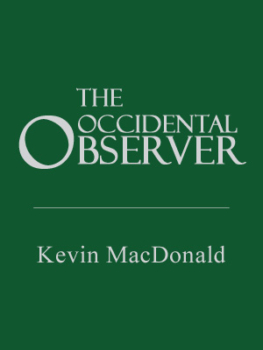

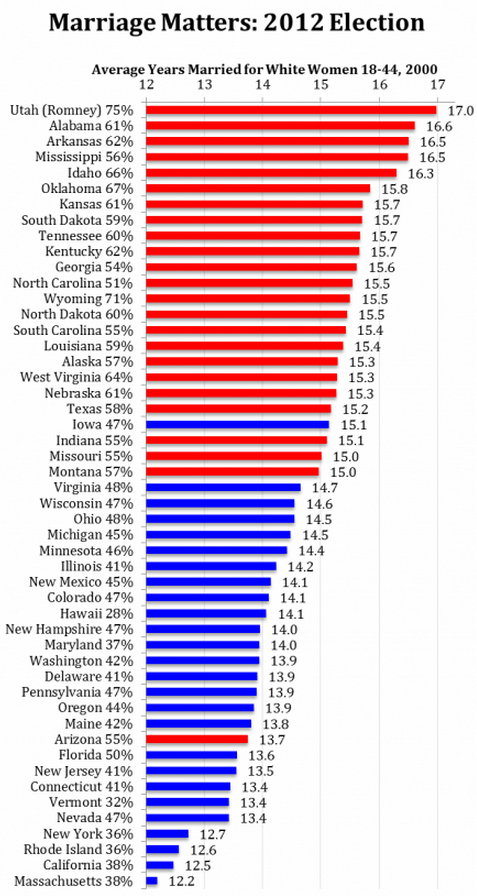



 One of the victims
One of the victims 
